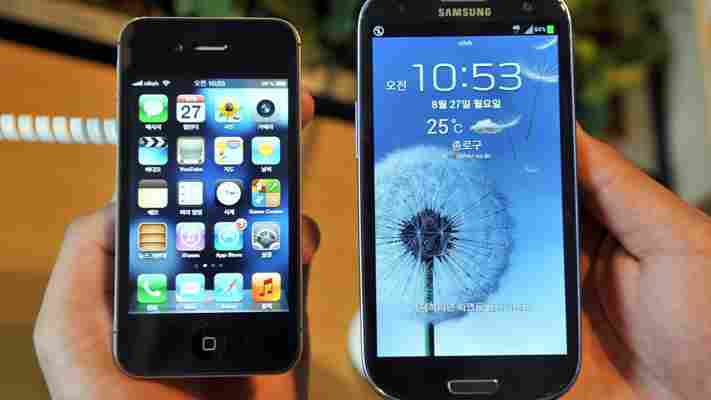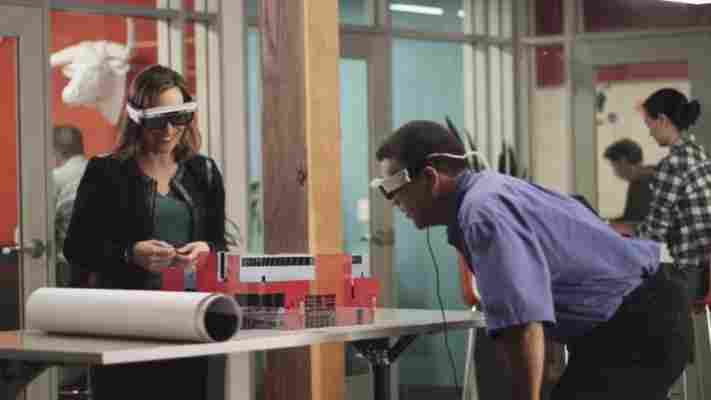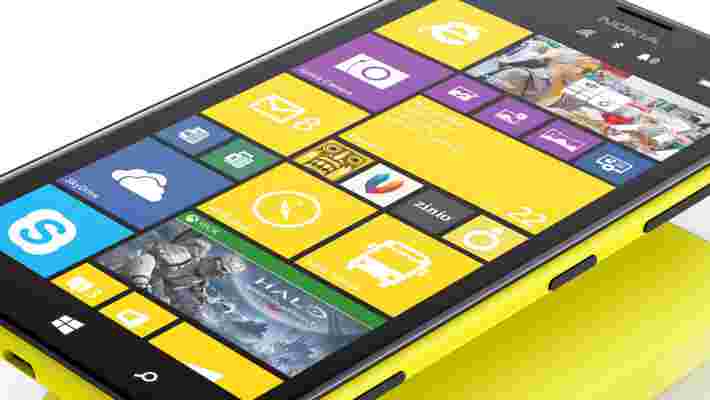Another month, another report showing Apple’s dominance as the top US smartphone company has peaked at just above 41 percent. Samsung, meanwhile, is taking advantage by gaining share faster than its main competitor, pushing its way to 27 percent. Rounding out the top five were LG, Motorola, and HTC.

On the platform side, Google remains at the top with Android and Apple is second with iOS. While Google’s mobile platform has slipped multiple times last year, and started off losing share at the start of 2014, it has managed to outgain Apple’s platform over the last couple months. Rounding out the top five were Microsoft, BlackBerry, and Symbian.
The latest data comes from comScore , which every month surveys over 30,000 mobile subscribers in the US. The market research firm says 166 million Americans owned smartphones (68.8 percent mobile market penetration) in March, up 6 percent since December.
During the quarter, here is how the top five smartphone OEMs fared:
Apple slipped 0.4 percentage points in smartphone subscribers (from 41.8 percent to 41.4 percent) while Samsung grabbed 0.9 percentage points (from 26.1 percent to 27.0 percent). Samsung outgained Apple in more months than not during 2013. In 2014, the South Korean company has beat the American one in all three months so far. With the Galaxy S5 launching in more countries and on more carriers, that likely won’t change until the iPhone 6 arrives.
LG gained 0.1 points (to 6.7 percent), Motorola slipped 0.3 points (to 6.4 percent), and HTC dropped 0.3 points (to 5.4 percent). For many months now, this trio has been swapping places on the regular as each tries to gain a foothold for third place. HTC is hoping the M8 will fix its problems, Motorola is prepping a Moto X successor , but only LG has managed to recover, though we don’t have Nexus 5 sales numbers.
On the software side, Google continues to dominate. While Android lost share most months in 2013, and saw a drop in the first month in 2014, it has recovered for the following two months:
Google’s mobile operating system gained 0.7 points (from 51.5 percent to 52.2 percent). Apple meanwhile slipped to 41.4 percent, just like for its smartphone share.
BlackBerry was down 0.7 points (from 3.4 percent to 2.7 percent), Microsoft gained 0.2 points to 3.3 percent, and Symbian stayed at 0.2 percent. Windows Phone is starting to cement its third place position, which it grabbed from BlackBerry OS at the start of 2014. Nevertheless, the Android-iOS duopoly in the US hit a new high: 93.6 percent market share.
Top Image Credit: Jung Yeon-Je /Getty Images
If you backed this augmented reality Kickstarter, you’re getting a refund and your glasses
Augmented reality hardware maker CastAR has announced that it’s postponing delivery of its hologram-projecting glasses to 2017.

But it has good news for its Kickstarter campaign supporters: they’ll get their money back and receive a pair of glasses at no charge.
The company wrapped up its crowdfunding campaign last October, by which time it had received over $1 million from more than 3,000 backers.
It has decided to postpone shipping after it realized that many of its backers weren’t developers who wanted to build software for the device, but were everyday consumers who wanted an augmented reality headset with content they could enjoy right out of the box.
So instead of delivering prototype-level hardware today, the company says it will wait to send out consumer-grade devices to all backers who pledged money towards hardware reward tiers — and refund their money from the start of next year.
CastAR’s generous move is made possible by its $15 million series A funding round , which it scored from Android creator Andy Rubin’s Playground Global venture capital firm .
Delaying the rollout also allows the company to ditch its initial plans of offering various combinations of glasses and accompanying controllers, and ensure that every customer gets the same hardware set.
That makes it easier for developers to build games and experiences; they’d otherwise have to account for some users not having a controller to interact with their software.
CastAR CEO David Henkel-Wallace told GamesIndustry.biz in an interview:
Wallace added that the consumer sets will get upgrades in terms of usability, all-day play, simplified setup and reduced dependence on various cables. The company has already shaved half the weight off its glasses, so they’re now under 70 grams.
With that, CastAR is setting itself up to give users a taste of augmented reality entertainment ahead of similar ventures like Microsoft’s HoloLens (which is slated to launch in 2020 for consumers). But in addition to delivering hardware that meets customers’ expectations, it’ll also have to excite content creators enough so they can offer a sizable pool of games and experiences at launch.
➤ CastAR to pay back Kickstarter backers [GamesIndustry.biz]
Nokia announces two 6 smartphones: the $739 Lumia 1520 for Q4 2013 and the $339 Lumia 1320 for Q1 2014
At Nokia World in Abu Dhabi today, Nokia today added two large-screen devices to its portfolio of Lumia smartphones: the Lumia 1520 and the Lumia 1320. Both ship with Windows Phone 8 and feature a 6-inch screen, though the former has a 1080p display and the latter has a 720 display.

(Scroll down to see the first video of the Lumia 1520)
Despite the difference, both devices will be able to include a new third column of tiles on the home screen. This shows the close ties between Microsoft and Nokia: the latter is well-aware of the former’s decision to have the extra Windows Phone tiles depend on screen size rather than resolution.
The Nokia Lumia 1520 will be available for $749 in yellow, white, black, and glossy red. It is expected to start shipping in Q4 2013 across the US, the UK, Hong Kong, Singapore, China, France, Germany, Finland, and other European markets, with other markets to follow.
The Nokia Lumia 1320 meanwhile will be available for $339 in orange, yellow, white, and black. It is expected to start shipping in Q1 2014 in China and Vietnam, followed by other Asian markets, India, and Europe. It will not be coming to the US.
The Lumia 1520 features a 20MP PureView camera with optical image stabilization (OIS). It also ships with Nokia Rich Recording, an audio capture tool that leverages the device’s four built-in microphones.
Here are the Lumia 1520 specifications:
6″ full HD 1080p LCD, ClearBlack, Sunlight readability, Super sensitive touch, Gorilla Glass 2
PureView 20 MP, ZEISS optics, OIS, 2x lossless zoom, oversampling, dual LED flash
Video 1080p @ 30 fps full HD video with optical image stabilization
4G LTE
Nokia Music for unlimited streaming of ad-free music
Free global HERE Maps and HERE Drive+, HERE Transit available in the Store
Microsoft Office built-in
Qualcomm Snapdragon 800 (2.2GHz Quad Core)
3400 mAh (integrated) with built-in wireless charging
Yellow, white, black, glossy red
There are currently more details for the Lumia 1520 than the Lumia 1320 (which is not pictured) since the former is shipping before the latter. Exact release dates for both aren’t known, however, but we’ll let you know the second we’re aware of them.
Image Credits: Nokia
